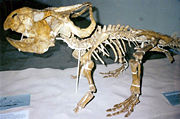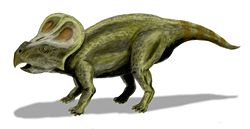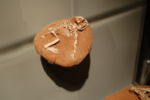Protoceratops
2008/9 Schools Wikipedia Selection. Related subjects: Dinosaurs
| Protoceratops Fossil range: Late Cretaceous |
||||||||||||||||||
|---|---|---|---|---|---|---|---|---|---|---|---|---|---|---|---|---|---|---|
 Protoceratops skeleton at Wyoming Dinosaur Centre.
|
||||||||||||||||||
| Scientific classification | ||||||||||||||||||
|
||||||||||||||||||
| Species | ||||||||||||||||||
|
Protoceratops (meaning 'First Horned Face', derived from Greek proto-/πρωτο- 'first', cerat-/κερατ- 'horn' and -ops/-ωψ face) is a genus of sheep-sized (1.5 to 2 m long) herbivorous ceratopsian dinosaur, from the Upper Cretaceous Period ( Campanian stage) of what is now Mongolia. It was a member of the Protoceratopsidae, a group of early horned dinosaurs. Unlike later ceratopsians, however, it lacked well-developed horns and retained some primitive traits not seen in later genera.
Protoceratops had a large neck frill, which may have served to protect the neck, to anchor jaw muscles, to impress other members of the species, or combinations of these functions. Described by Walter Granger and W.K. Gregory in 1923, Protoceratops was initially believed to be an ancestor of the North American ceratopsians. Researchers currently distinguish two species of Protoceratops (P. andrewsi and P. hellenikorhinus), based in part by their respective sizes.
Description
Protoceratops was approximately 1.8 meters (6 ft) in length and 0.6 meters (2 ft) high at the shoulder. This quadrupedal dinosaur had a neck frill at the back of its skull. The exact size and shape of the neck frill varied by individual; some specimens had short, compact frills, while others had frills nearly half the length of the skull. The frill consists mostly of the parietal bone and partially of the squamosal. Some researchers, including Peter Dodson attribute the different sizes and shapes of these bones to sexual dimorphism and the age of the specimen. Protoceratops was a relatively small dinosaur with a proportionately large skull. The skull consisted of a massive frontal beak and four pairs of fenestrae (skull openings). The foremost hole was the naris, which was considerably smaller than the nostrils seen in later genera. Protoceratops had large orbits (the holes for its eyes), which measured around 50 millimeters in diameter. Behind the eye was a slightly smaller fenestra, the infratemporal fenestra. The frill itself contained two large parietal fenestra (holes in the frill), while its cheeks had large jugal bones.
Discovery and species

Photographer J.B. Shackelford discovered the first specimen of Protoceratops in the Gobi desert, ( Gansu, Inner Mongolia), as part of a 1922 American expedition looking for human ancestors. No early human fossils were found, but the expedition, led by Roy Chapman Andrews, collected many specimens of the Protoceratops genus, along with fossil skeletons of theropods Velociraptor, Oviraptor, and ceratopsid Psittacosaurus.
Walter Granger and W.K. Gregory formally described the type species, P. andrewsi in 1923, the specific name in honour of Andrews. The fossils date from the Campanian stage of the Upper Cretaceous (83.5 to 70.6 million years ago). Researchers immediately noted the importance of the Protoceratops finds, and the genus was hailed as the "long-sought ancestor of Triceratops". The fossils were in an excellent state of preservation, with even the sclerotic rings (delicate occular bones) preserved in some specimens.
In 1971, a fossil was found that captured a Velociraptor clutched around a Protoceratops in Mongolia. It is believed that they died simultaneously, while fighting, when they were either surprised by a sand storm or buried when a sand dune collapsed on top of them.
In 1975, Polish paleontologists Teresa Maryanska and Halszka Osmólska described a second species of Protoceratops, from the Campanian stage of Mongolia, which they named P. kozlowskii. However, the fossils consisted of incomplete juvenile remains, and are now considered synonymous with Bagaceratops rozhdestvenskyi.
In 2001, a second valid species, P. hellenikorhinus, was named from the Bayan Mandahu formation in Inner Mongolia, China and also dates from the Campanian epoch of the Upper Cretaceous. It is notably larger than P. andrewsi, had a slightly different frill, and had more robust jugal horns.
In the 1920s, Roy Chapman Andrews discovered the first known fossilized dinosaur eggs, in the Gobi Desert of Mongolia. Due to the proximity of Protoceratops, these eggs were believed at the time to belong to this species. The nearby theropod Oviraptor was thought to have been engaged in the process of stealing and eating them. However, in 1993 Norrell et al. discovered an Oviraptor embryo inside a supposed Protoceratops egg.
Classification
Protoceratops was the first named protoceratopsian and hence gives its name to the family Protoceratopsidae, a group of herbivorous dinosaurs that were too advanced to be psittacosaurids, but too primitive to be ceratopsids. The group is characterized by their similarities to the ceratopsidae but with more cursorial limb proportions and generally smaller frills. In 1998, Paul Sereno defined Protoceratopsidae as the stem-based clade including "all coronosaurs closer to Protoceratops than to Triceratops." The clade also includes Bagaceratops, Breviceratops, Graciliceratops, Lamaceratops, Magnirostris, Platyceratops, and Serendipaceratops.
Origin of griffin myths
Folklorist and historian of science Adrienne Mayor of Stanford University has suggested that the exquisitely preserved fossil skeletons of Protoceratops and other beaked dinosaurs, found by ancient Scythian nomads who mined gold in the Tian Shan and Altai Mountains of Central Asia, may have been at the root of the image of the mythical creature known as the griffin. Griffins were described as lion-sized quadrupeds with large claws and a raptor-bird-like beak; they laid their eggs in nests on the ground. Greek writers began describing the griffin around 675 B.C., at the same time the Greeks first made contact with Scythian nomads. Griffins were described as guarding the gold deposits in the arid hills and red sandstone formations of the wilderness. The region of Mongolia and China where many Protoceratops fossils are found is rich in gold runoff from the neighboring mountains, lending some credence to the theory that these fossils were the basis of griffin myths.



